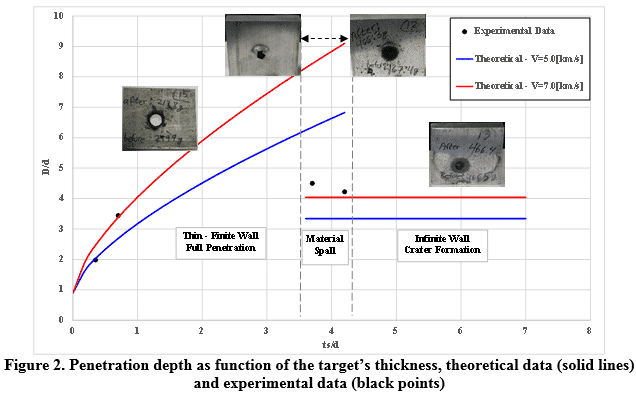Abstract
Investigation of the mass-loss of various targets during a hypervelocity impact is presented. Few models exist to predict the outcome of a hypervelocity impact between two bodies. Each model fits a specific case. This paper deals with an engineering model which was developed by modification of known models. The model predicts the influence of a hypervelocity impact of a small body with a large target (thin or thick). The targets for which the model was developed and fitted are for aluminium, steel, nylon and graphite materials, when the projectiles are small aluminium spheres. The model was then validated with experimental data gathered during a laboratory hypervelocity experiment, called PISA (conducted by McGill University).
A hypervelocity impact occurs when the relative velocity between two colliding objects is close to or exceeds the speed of sound in the object`s materials (usually ΔVimpact > 4 [km/sec]). During such an impact, which involves very high amounts of kinetic energy and pressures, a supersonic compression shock wave is formed at the contact surface between the objects and spreads in a round pattern across the target, followed by a relief wave. These shock waves, followed by high temperatures and pressures gradients, form strong strains, material deformation and, in most hypervelocity impacts, destruction of parts of the target material. These effects propagate much deeper and farther from the collision point (in comparison to the characteristic size of the hitting projectile).
There are three main outcomes of a hypervelocity impact between a hard, small projectile and a plate-type large target, as shown in Figure 1:
- The projectile fully penetrates the target and exits from the other side of it, leaving a cylindrical hole in the target (Figure 1a).
- The projectile does not exit from the other side, but the impact is so strong that the shock waves propagation causes material spall from the back side of the target (Figure 1b) in addition to the target material exhausted from the front surface.
- The projectile penetrates into the target and stays in it without causing any observable consequences at the back side of the target (Figure 1c).
It is important to notice that for any type of hypervelocity impact a great amount of the target mass is ejected in the opposite direction from the projectile velocity vector out of the impacted side of the target.

The type of the impact and the target’s mass-loss depend on the impact velocity and the ratio (projectile-target) of strength and hardness by Brinell’s criteria. The higher the impact velocity, the deeper the crater that the projectile creates in the target (Figure 1c), up to the point where begins a spillage of the target mass from its back side (see, Figure 1b). At a sufficiently high impact velocity, a cylindrical hole is formed. Its diameter is remarkably larger than that of the projectile (Figure 1a).
Figure 2 shows the relation between the target thickness (ts), normalized by the projectile’s diameter (d) and the diameter (D) of the resulted crater or hole (also normalized by the projectile`s diameter). The red and blue lines represent theoretical calculations, using the developed model, of the diameter of the crater/hole, for two impact velocities (7 and 5 km/s respectively) and the black dots show PISA experimental results:

The PISA test procedure includes the targets weighing (before and after the projectile impact), a procedure that was not considered and underwent in the reviewed literature. This procedure provides important data for the developed model evaluation and validation (impulse calculations, for example). The data analysis showed that for an impact at the velocity of 7 km/s the mass ejected from the target is greater than the impactor mass by a factor of 8 for the thick target (ts/d>4.5, crater formation) and by a factor of 14 for the thin target (ts/d<3.5, cylindrical hole formation).
The investigation also considered multi-layer targets, in which a metallic main target is covered by a thin layer of non-metallic material, such as graphite or nylon (for protection purposes). It was shown that the effect of the impact on the main, metallic target is much lower than on a single-layer target. An impact that should have been resulted in full penetration of a single-layer target, actually resulted in a small crater formation in the metallic target, while the protective layer underwent a severe destruction.
It was shown that the developed engineering model gives a very good prediction for metallic projectiles impacting a metallic target (both thin and thick) at impact velocities of (normalized to target’s speed of sound). More research is needed for developing predictions of impacts involving non-metallic and multi-layer targets.

